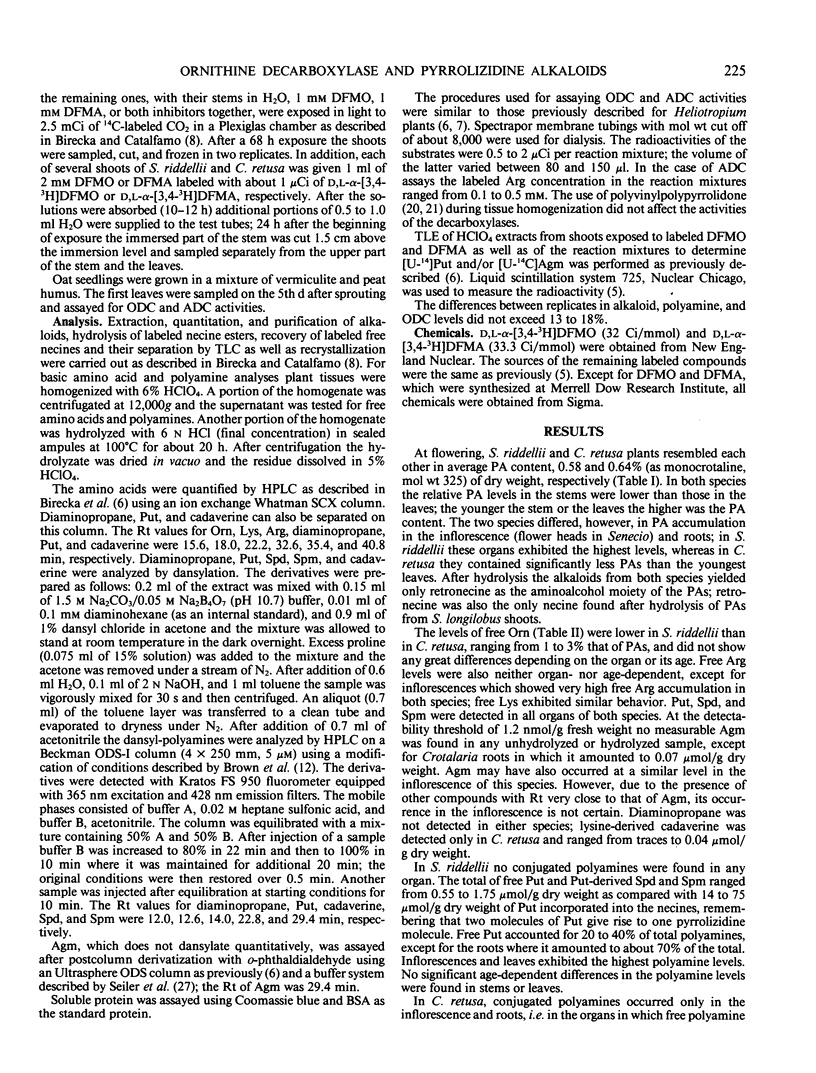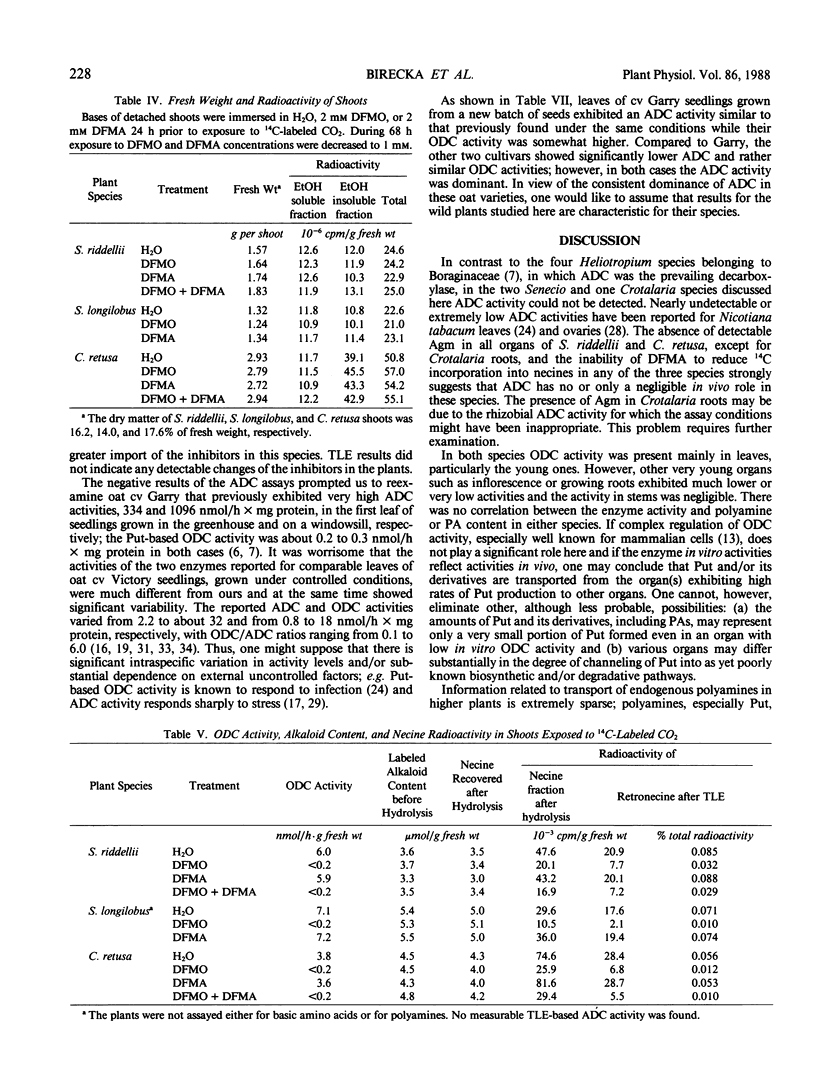Abstract
When tested for ornithine and arginine decarboxylases, pyrrolizidine alkaloid-bearing Senecio riddellii, S. longilobus (Compositae), and Crotalaria retusa (Leguminosae) plants exhibited only ornithine decarboxylase activity. This contrasts with previous studies of four species of pyrrolizidine alkaloid-bearing Heliotropium (Boraginaceae) in which arginine decarboxylase activity was very high relative to that of ornithine decarboxylase. Unlike Heliotropium angiospermum and Heliotropium indicum, in which endogenous arginine was the only detectable precursor of putrescine channeled into pyrrolizidines, in the species studied here—using difluoromethylornithine and difluoromethylarginine as the enzyme inhibitors—endogenous ornithine was the main if not the only precursor of putrescine converted into the alkaloid aminoalcohol moiety. In S. riddellii and C. retusa at flowering, ornithine decarboxylase activity was present mainly in leaves, especially the young ones. However, other very young organs such as inflorescence and growing roots exhibited much lower or very low activities; the enzyme activity in stems was negligible. There was no correlation between the enzyme activity and polyamine or alkaloid content in either species. In both species only free polyamines were detected except for C. retusa roots and inflorescence—with relatively very high levels of these compounds—in which conjugated putrescine, spermidine, and spermine were also found; agmatine was not identified by HPLC in any plant organ except for C. retusa roots with rhizobial nodules. Organ- or age-dependent differences in the polyamine levels were small or insignificant. The highest alkaloid contents were found in young leaves and inflorescence.
Full text
PDF






Selected References
These references are in PubMed. This may not be the complete list of references from this article.
- Birecka H., Birecki M., Frohlich M. W. Evidence for arginine as the endogenous precursor of necines in heliotropium. Plant Physiol. 1987 May;84(1):42–46. doi: 10.1104/pp.84.1.42. [DOI] [PMC free article] [PubMed] [Google Scholar]
- Birecka H., Bitonti A. J., McCann P. P. Activities of arginine and ornithine decarboxylases in various plant species. Plant Physiol. 1985 Oct;79(2):515–519. doi: 10.1104/pp.79.2.515. [DOI] [PMC free article] [PubMed] [Google Scholar]
- Birecka H., Bitonti A. J., McCann P. P. Assaying ornithine and arginine decarboxylases in some plant species. Plant Physiol. 1985 Oct;79(2):509–514. doi: 10.1104/pp.79.2.509. [DOI] [PMC free article] [PubMed] [Google Scholar]
- Brown N. D., Strickler M. P., Whaun J. M. Femtomolar ion-pair high-performance liquid chromatographic method for determining Dns-polyamine derivatives of red blood cell extracts utilizing an automated polyamine analyzer. J Chromatogr. 1982 Aug 6;245(1):101–108. doi: 10.1016/s0021-9673(00)82479-6. [DOI] [PubMed] [Google Scholar]
- Canellakis E. S., Kyriakidis D. A., Rinehart C. A., Jr, Huang S. C., Panagiotidis C., Fong W. F. Regulation of polyamine biosynthesis by antizyme and some recent developments relating the induction of polyamine biosynthesis to cell growth. Review. Biosci Rep. 1985 Mar;5(3):189–204. doi: 10.1007/BF01119588. [DOI] [PubMed] [Google Scholar]
- Flores H. E., Galston A. W. Polyamines and plant stress: activation of putrescine biosynthesis by osmotic shock. Science. 1982 Sep 24;217(4566):1259–1261. doi: 10.1126/science.217.4566.1259. [DOI] [PubMed] [Google Scholar]
- Friedman R., Levin N., Altman A. Presence and identification of polyamines in xylem and Phloem exudates of plants. Plant Physiol. 1986 Dec;82(4):1154–1157. doi: 10.1104/pp.82.4.1154. [DOI] [PMC free article] [PubMed] [Google Scholar]
- Kaur-Sawhney R., Shih L. M., Flores H. E., Galston A. W. Relation of polyamine synthesis and titer to aging and senescence in oat leaves. Plant Physiol. 1982 Feb;69(2):405–410. doi: 10.1104/pp.69.2.405. [DOI] [PMC free article] [PubMed] [Google Scholar]
- Loomis W. D. Overcoming problems of phenolics and quinones in the isolation of plant enzymes and organelles. Methods Enzymol. 1974;31:528–544. doi: 10.1016/0076-6879(74)31057-9. [DOI] [PubMed] [Google Scholar]
- Molyneux R. J., Johnson A. E. Extraordinary levels of production of pyrrolizidine alkaloids in Senecio riddellii. J Nat Prod. 1984 Nov-Dec;47(6):1030–1032. doi: 10.1021/np50036a024. [DOI] [PubMed] [Google Scholar]
- Seiler N., Knödgen B. High-performance liquid chromatographic procedure for the simultaneous determination of the natural polyamines and their monoacetyl derivatives. J Chromatogr. 1980 Dec 12;221(2):227–235. doi: 10.1016/s0378-4347(00)84307-8. [DOI] [PubMed] [Google Scholar]
- Slocum R. D., Galston A. W. Changes in polyamine biosynthesis associated with postfertilization growth and development in tobacco ovary tissues. Plant Physiol. 1985;79:336–343. doi: 10.1104/pp.79.2.336. [DOI] [PMC free article] [PubMed] [Google Scholar]
- Weinstein L. H., Kaur-Sawhney R., Rajam M. V., Wettlaufer S. H., Galston A. W. Cadmium-induced accumulation of putrescine in oat and bean leaves. Plant Physiol. 1986;82:641–645. doi: 10.1104/pp.82.3.641. [DOI] [PMC free article] [PubMed] [Google Scholar]
- Young N. D., Galston A. W. Physiological control of arginine decarboxylase activity in k-deficient oat shoots. Plant Physiol. 1984 Oct;76(2):331–335. doi: 10.1104/pp.76.2.331. [DOI] [PMC free article] [PubMed] [Google Scholar]
- Young N. D., Galston A. W. Putrescine and Acid Stress : Induction of Arginine Decarboxylase Activity and Putrescine Accumulation by Low pH. Plant Physiol. 1983 Apr;71(4):767–771. doi: 10.1104/pp.71.4.767. [DOI] [PMC free article] [PubMed] [Google Scholar]


